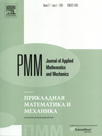 | | Journal of Applied
Mathematics and Mechanics
Russian Academy of Sciences | | Founded
in January 1936
(Translated from 1958)
Issued 6 times a year
ISSN 0021-8928
(print version) |
Archive of Issues
| Total articles in the database: | | 10610 |
| In Russian (ΟΜΜ): | | 9811
|
| In English (J. Appl. Math. Mech.): | | 799 |
|
| << Previous article | Volume 78, Issue 4 / 2014 | Next article >> |
| V.B. Penkov, L.V. Satalkina, and A.S. Shulmin, "The use of the method of boundary states to analyse an elastic medium with cavities and inclusions," J. Appl. Math. Mech. 78 (4), 384-394 (2014) |
| Year |
2014 |
Volume |
78 |
Issue |
4 |
Pages |
384-394 |
| Title |
The use of the method of boundary states to analyse an elastic medium with cavities and inclusions |
| Author(s) |
V.B. Penkov (Lipetsk, Russia, vbpenkov@Mail.Ru)
L.V. Satalkina (Lipetsk, Russia, satalkina_lyubov@mail.ru)
A.S. Shulmin (Lipetsk, Russia) |
| Abstract |
The analytical method of boundary states is developed and theoretically substantiated. A corollary of the Weierstrass theorem is proved according to which a function that is harmonic in a bounded, simply connected domain can be approximated by a series of homogeneous harmonic polynomials. A basis of the space of functions that are harmonic outside any neighbourhood of a point is constructed. An algorithm is developed for filling the basis of the space of the states of a multicavity elastic body. The method is used to solve a series of problems of determining of the stress-strain state of an unbounded elastic medium containing spherical cavities or inclusions with different boundary conditions: the boundary of the cavity is free (the Southwell problem), constrained or under conditions of contact with a rigid core. The effect of the width of the intercavity layer on the stress concentration is analysed in a non-axisymmetric problem with two cavities. The form of the relation between the mean-square discrepancy in the boundary conditions of the solution obtained and the number of elements in the basis is indicative of the numerical convergence of the solution of this problem. |
| Received |
20 August 2012 |
| Link to Fulltext |
|
| << Previous article | Volume 78, Issue 4 / 2014 | Next article >> |
|
 If you find a misprint on a webpage, please help us correct it promptly - just highlight and press Ctrl+Enter If you find a misprint on a webpage, please help us correct it promptly - just highlight and press Ctrl+Enter
|
|

 Russian
Russian  English
English